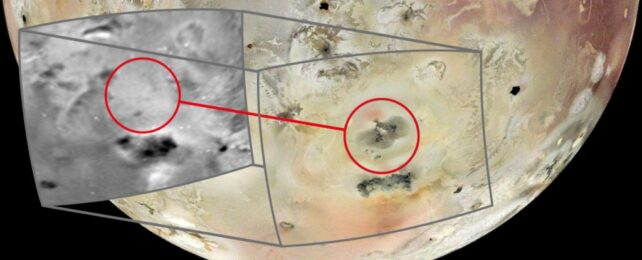Jupiter's moon, Io, is the most volcanic body in the Solar System.
NASA's Juno spacecraft has been getting closer and closer to Io in the last couple of years, giving us our first close-up images of the moon in 25 years.
Recent JunoCam images show a new volcano that appeared sometime after the Galileo spacecraft visited the region.
The new volcano is just south of Io's equator. Since tidal heating from Jupiter causes Io's volcanic activity, most volcanoes are in the moon's equatorial region, within about 30 degrees north and south of the equator.

When NASA's Galileo spacecraft imaged the region where the new volcano was spotted in 1997, the surface was featureless.
The new volcano is near an existing volcano called Kanehekili. JunoCam's image from April 2024 revealed multiple lava flows and volcanic deposits covering an area of about 180 kilometres by 180 kilometres.
"Our recent JunoCam images show many changes on Io, including this large, complicated volcanic feature that appears to have formed from nothing since 1997," said Michael Ravine.
Ravine is the Advanced Projects Manager at Malin Space Science Systems, the company that built and operates JunoCam for NASA's Juno mission.
Of course, the volcano didn't form from nothing. Io is in a tough spot orbitally.

Tidal friction from massive Jupiter, and some from its fellow moon Europa, is dissipated as orbital and heat energy in Io. In its sibling ocean moons like Europa, Ganymede, and Callisto, the heat keeps their subsurface oceans in liquid form.
But Io doesn't have an ocean, so the heat causes magma to well up and break through the surface as volcanoes. Io has over 400 active volcanoes, and the surface is covered in sulphuric compounds from these eruptions, which give it its colours.
JunoCam's best image of the region and the new volcano was taken on February 3rd, 2024, from a distance of about 2,530 km. The scale is about 1.7 km per pixel. In this image, Io is illuminated with sunlight reflected off of Jupiter.

There are unanswered questions about Io, its volcanism, and its interior composition.
Scientists know that tidal heating from Jupiter is the moon's primary heat source, but they aren't certain how the heat is distributed inside. They are also uncertain about the extent of Io's magma ocean.
They also want to know what initiates eruptions and what drives the different types of eruptions, like plumes, lava flows, and pyroclastic flows.
There are unanswered questions about Io's volcanic history and how often the surface is reshaped. There are no impact craters on Io, which means the surface must be young.

Researchers are also keen to understand how the gases from eruptions might affect the surface and the moon's extremely thin atmosphere. Io's volcanic activity has likely changed over time, and how that happens and what drives it are also unknown.
Answers to these questions will not only help us understand Io, but other rocky planets as well.
Juno's discovery of a new volcano on Io is interesting, and its observations are a valuable contribution to the body of knowledge. However, Juno won't provide the in-depth answers scientists seek.
It has several more flybys of Io in the future, with the last one in 2025. Unfortunately, it'll be getting further from the moon, and the last one will be at a distance of 94,000 km.

These images do highlight an important part of the Juno mission, though. The JunoCam isn't a scientific instrument, strictly speaking. It was included for the rest of us, and the images are freely available for anyone to work on and post.
By spotting the new volcano, JunoCam has proven its scientific value.
This article was originally published by Universe Today. Read the original article.
